- American History
- Ancient History
- European History
- Military History
- Medieval History
- Latin American History
- African History
- Historical Biographies
- History Book Reviews
- Sign in / Join


Comparing Mesopotamia and Egypt

Egypt and Mesopotamia developed within close proximity and time frames to one another, but in drastically different ways. Part of these differences was due to geography, part was due to law codes, and part was due to social structure and government. Both civilizations followed a similar pattern in their origins, but diverged as they became more complex.
Domestication of animals was crucial in taking wandering nomads and rooting them to one spot.
Soon they would learn to stray even less with the advent of agriculture and the constant care required by it. Wheeled carts, sailboats, the smelting of metal, irrigation, and calendars all contributed to the stability required by agrarian life in small communities.
The founders of new settlements eventually became kings of nations. With specialized diversity allowing various roles to be developed in the community, religion became a powerful culture all its own. Priests exercised various levels of control in the small and large cities where they resided and theology frequently guided political thought.
As the kings and priests wished to exert authority, internal policing units were created to enforce the laws of the authority figure. Eventually the police diversified to a military force for protection against rival nations. Stability and security ensued for those with an armed force that could protect the borders.
Society was made more complex by the development of trade, which naturally led to diplomacy between nations. Writing and the advent of currencies helped to promote business and education. And with the new interactions among different cultures of the ancient world came tolerances and variety, as well as misunderstandings and violence.
Life in cities also changed socially. No more did everyone know everyone intimately as in the pastoral village. Now you spoke with someone only as an interaction requiring services or goods. Relationships became compartmentalized and partial. However, unlike village life, which promoted conformity, large cities promoted new styles and technologies, and culture developed as a result.
There were differences as to the role of nature between Egypt and Mesopotamia. Due to the predictable seasonal flooding of the Nile, the farmers in Egypt welcomed the event. Likewise they spread out along the river and government was decentralized as one moved further from the capital. As a result, the people of Egypt were more relaxed and seemed to have an easiness about them as the Nile faithfully brought them abundance.
In Mesopotamia the atmosphere was different. The flooding of the rivers was sporadic and deemed the anger of the gods manifest. Cities were more centralized and compact, with winding streets and multi-floored residential housing. Nothing of this type was found on the Nile floodplain. The residents of Mesopotamia seemed to live a more hectic and uncertain life than those of Egypt and the government had direct and immediate control over the lives of the citizens.
The history of Egypt and Mesopotamia show how geography can affect the progress, direction, and even social life of a civilization. Although they developed at similar times and in similar locations, they grew to become drastically different within close proximity and time frames to one another, but in drastically different nations.
RELATED ARTICLES MORE FROM AUTHOR

The Babylonian Captivity: The Influence of King Nebuchadnezzar II on the Jewish Exiles

The Domestic Roots of Ancient Alchemy: Women’s Work and their Role in the Science of Alchemy

The Legend of Dido: How the Myth of Carthage’s Legendary Queen Evolved

The First Paper: The Papyrus of Ancient Egypt

Amazons – Who Were the Ancient Female Warriors?

The Kyrenia Ship: Her Last Voyage

- Pantone Colors

Compare And Contrast the Ancient Civilizations of Mesopotamia And Egypt
The ancient civilizations of Mesopotamia and Egypt were both cradles of civilization, exhibiting many similarities due to their geographical locations, but differing in various ways such as political structures, religious beliefs, and cultural practices.
Quick Overview
Mesopotamia and Egypt , two of the ancient world’s most remarkable civilizations, developed sophisticated systems of governance, culture, and technology, largely influenced by their geographical settings along fertile river valleys.
Despite commonalities, their contrasting political structures and religious beliefs carved out unique identities for these civilizations.
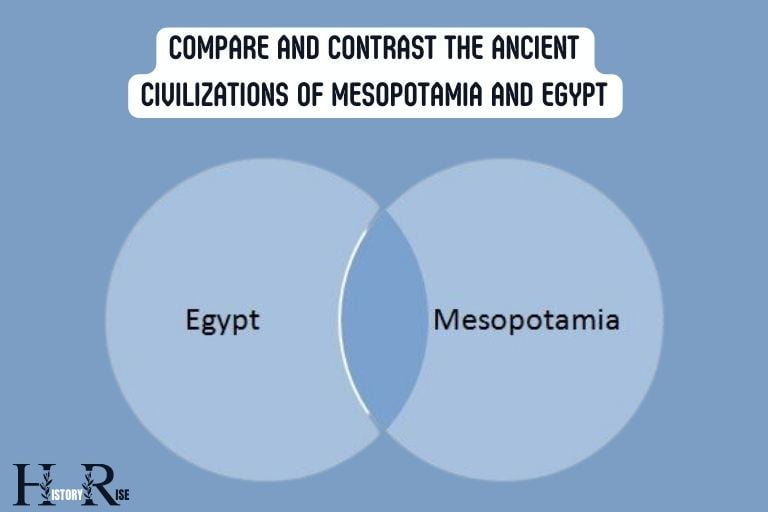
Table of Contents
Historical Background of: Mesopotamia
Historical background of: egypt, achievements and contributions mesopotamia, achievements and contributions egypt, five facts about the ancient civilizations of mesopotamia and egypt, the geography of mesopotamia and egypt.
Ancient civilizations captivate us with their rich histories and remarkable achievements. Two such civilizations that continue to intrigue scholars and enthusiasts are mesopotamia and egypt.
Journeying back to thousands of years ago, we can explore the fascinating geography of these civilizations and understand how it influenced their development.
In this section, we will delve into the geographical features and resources of mesopotamia and egypt, while also examining the impact of geography on their respective civilizations.
Geographical Features And Resources:
Mesopotamia:
- Located in the fertile region between the tigris and euphrates rivers.
- Consisted of vast plains, with occasional hills and mountains.
- The rivers provided a reliable water source for farming and irrigation.
- The fertile soil supported the growth of crops such as barley, wheat, and dates.
- Natural resources included clay for pottery and building materials, as well as timber for construction.
- Situated in the northeastern corner of africa, along the nile river.
- Dominated by the vast sahara desert, with the nile valley running through it.
- The nile river was the lifeblood of egypt, providing water, transportation, and fertile soil.
- Egypt’s agriculture thrived due to the annual flooding of the nile, which enriched the land.
- The land along the nile allowed the cultivation of crops like wheat, barley, flax, and papyrus.
- Valuable resources included gold, limestone, and fertile black soil (known as “kemet”).
Impact Of Geography On Civilization Development:
- The rivers greatly influenced the development of agriculture, allowing for surplus food production and the growth of complex societies.
- The lack of natural barriers made the region prone to invasions, leading to frequent conflicts and the rise and fall of various empires.
- The presence of clay and rivers enabled the development of early writing systems, such as cuneiform, facilitating record-keeping and the spread of knowledge.
- The nile river served as a natural barrier, protecting egypt from invasions and contributing to its long-lasting stability and continuity.
- The predictability of the nile’s annual flooding allowed for efficient agricultural planning and a reliable food supply, enabling the growth of a sophisticated society.
- The desert served as a protective shield, isolating egypt and fostering a unique cultural identity that sustained for thousands of years.
The geography of mesopotamia and egypt played a pivotal role in shaping their civilizations. From the abundance of resources provided by the rivers to the challenges posed by the surrounding landscapes, these ancient civilizations adapted and thrived.
By understanding their geographical foundations, we gain valuable insights into the factors that influenced their development and enduring legacies.
Economy And Trade In Mesopotamia And Egypt
Mesopotamia and egypt were two ancient civilizations that thrived in different regions but shared similarities in their economies and trade networks.
Understanding the economic systems and trading practices of these civilizations provides valuable insights into their societal structures and cultural dynamics.
In this section, we will explore the agriculturally based economies, as well as the trade networks and connections with neighboring civilizations in mesopotamia and egypt.
Agriculturally Based Economies
Both mesopotamia and egypt relied heavily on agriculture as the foundation of their economies.
Here are key points that highlight the agriculturally based economies of these civilizations:
- The fertile land between the tigris and euphrates rivers provided a favorable environment for agriculture.
- Farmers utilized irrigation systems to control water flow and maximize crop production.
- Wheat, barley, and dates were common crops cultivated in mesopotamia.
- Surpluses of agricultural products allowed for trade and the development of specialized labor.
- The concept of private property emerged, leading to economic differentiation between social classes.
- The nile river’s annual flooding enriched the soil, creating fertile farmland.
- Farmers relied on the predictable flood cycles and developed impressive irrigation systems.
- Egyptian agriculture focused on crops like wheat, barley, and flax, alongside abundant fruits and vegetables.
- The abundance of resources stimulated trade and contributed to the prosperity of the civilization.
- Temple estates and state-regulated agriculture played a significant role in the economy.
Trade Networks And Connections With Neighboring Civilizations
Both mesopotamia and egypt had extensive trade networks that connected them with neighboring civilizations.
Here are some notable aspects:
- Trade was a vital aspect of mesopotamian civilization, facilitated by the region’s strategic location.
- City-states like ur and uruk engaged in long-distance trade, exchanging goods such as textiles, metals, and agricultural products.
- Trade routes connected mesopotamia with the indus valley civilization, the persian gulf, and anatolia.
- The development of writing systems, particularly cuneiform, helped record and administer trade transactions.
- Traders faced risks such as theft, piracy, and inconsistent weights and measures, which led to the creation of legal codes to regulate commerce.
- Situated along the nile river, egypt served as a crossroad between africa and the eastern mediterranean, fostering extensive trade connections.
- Egyptian merchants traded goods such as gold, papyrus, textiles, and precious stones with nubia, the levant, and the aegean region.
- The pharaohs actively participated in trade, establishing diplomatic relations and forming alliances through marriage.
- The development of a centralized bureaucracy enabled efficient regulation and taxation of trade activities.
- The ancient city of thebes, with its wealth and prominence, played a crucial role in trade networks and international diplomacy.
Both mesopotamia and egypt possessed agriculturally based economies that formed the backbone of their civilizations. These societies implemented advanced irrigation techniques, cultivated various crops, and achieved economic prosperity. .
Social Structures In Mesopotamia And Egypt
In ancient times, two great civilizations emerged in the world: mesopotamia and egypt. These civilizations had distinct social structures that played a significant role in shaping their respective societies.
In this section, we will delve deeper into the hierarchical structures of both mesopotamia and egypt, as well as the roles and responsibilities of different social classes.
Hierarchical Structures
- The social structure in mesopotamia was highly hierarchical, with individuals occupying different positions in society based on their birth, occupation, and wealth.
- At the top of the social hierarchy were the kings and the ruling elite, who held absolute power and controlled significant resources.
- Below the ruling elite were the priests and high-ranking military officials, who played crucial roles in maintaining religious and political order.
- The middle class consisted of artisans, merchants, and scribes, who enjoyed a certain level of financial stability and upward mobility.
- The majority of the population belonged to the lower class, which included the farmers, laborers, and slaves. They typically worked on the land owned by the ruling elites.
- Similarly, egypt also had a hierarchical social structure, but with some unique characteristics compared to mesopotamia.
- The pharaoh, considered a divine ruler, occupied the apex of the social hierarchy, embodying both political and religious authority.
- Just below the pharaoh were the high-ranking officials and nobles, who held significant power and enjoyed wealth and privileges.
- Priests, as intermediaries between the gods and people, also held prominent positions in egyptian society.
- The middle class included scribes, craftsmen, and merchants, who played essential roles in the economy and administration.
- The majority of the population consisted of farmers, laborers, and servants who worked the land and supported the stability of the kingdom.
Roles And Responsibilities Of Different Social Classes
- Kings and ruling elites were responsible for maintaining political stability, leading military expeditions, and ensuring the prosperity of their states.
- Priests played pivotal roles in religious rituals and ceremonies, interpreting the will of the gods, and maintaining social order through their influence.
- Artisans, merchants, and scribes contributed to the economic development of mesopotamian cities and supported the bureaucratic administration with their skills.
- The lower classes, such as farmers and laborers, were responsible for cultivating the land, producing food, and providing labor necessary for the functioning of society.
- Slaves, although at the bottom of the social hierarchy, played crucial roles in various aspects of mesopotamian life, such as agriculture, domestic work, and serving the ruling elites.
- The pharaohs were responsible for governing the kingdom, ensuring its security, and maintaining a harmonious relationship with the gods.
- High-ranking officials and nobles served as advisors to the pharaoh and held administrative positions within the government, overseeing different aspects of the kingdom.
- Priests played a central role in religious rituals, ensuring the gods’ favor and maintaining the cosmic order.
- Scribes were responsible for recording and documenting important information, such as religious texts, administrative records, and legal documents.
- Farmers, laborers, and servants were responsible for agricultural labor, construction projects, and providing services necessary for the smooth functioning of egyptian society.
Both mesopotamia and egypt had hierarchical social structures that played significant roles in shaping their civilizations.
Understanding these social structures and the responsibilities of different social classes provides insight into the functioning of these ancient societies.
Political Systems In Mesopotamia And Egypt
Mesopotamia and egypt were two ancient civilizations that emerged around the same time and flourished in different regions of the world. Both civilizations had unique political systems that contributed to their survival and growth over the centuries.
In this section, we will compare and contrast the political systems of mesopotamia and egypt, focusing on governance and ruling systems, as well as the role of kings and pharaohs.
Governance And Ruling Systems:
- City-states: Mesopotamia was composed of numerous independent city-states, each with its own ruler and government.
- Dynastic rule: Some city-states in mesopotamia were ruled by dynasties, where power was passed down through generations.
- Theocracy: In some city-states, rulers were chosen based on their connection to the gods, giving them religious authority.
- Pharaonic rule: Egypt was a centralized state ruled by pharaohs who held political and religious authority.
- Divine kingship: Pharaohs were believed to be the human incarnation of gods on earth, giving them absolute power.
- Bureaucracy: Egypt had a well-developed administrative system with officials responsible for various aspects of governance.
Kings And Pharaohs:
- Rulers as mediators: Kings in mesopotamia acted as intermediaries between the gods and the people, responsible for maintaining harmony.
- Military leaders: Kings were often military leaders who protected the city-states from external threats and led armies in times of war.
- Codified laws: Some mesopotamian kings, like hammurabi, implemented codified laws to maintain order within their territories.
- Divine rulers: Pharaohs in egypt were considered divine beings and the ultimate authority in all aspects of life.
- Guardians of ma’at: Pharaohs were responsible for upholding ma’at, the cosmic order of the universe, ensuring societal harmony.
- Monumental achievements: Pharaohs were known for their monumental building projects, such as the construction of pyramids and temples.
While both mesopotamia and egypt had distinct political systems, mesopotamia had a more decentralized and fragmented governance structure with city-states ruled by dynasties, while egypt had a centralized power with pharaohs who were considered divine rulers.
Understanding the political systems of these ancient civilizations provides valuable insights into their societal structures and values.
Religion And Beliefs In Mesopotamia And Egypt
Mesopotamia and egypt were two ancient civilizations with rich religious and belief systems, influencing their daily lives and shaping their societies.
Let’s delve into the details of their respective religion and beliefs and explore the similarities and differences between the two civilizations.
Pantheons And Gods
Both mesopotamia and egypt had pantheons of gods, but the number and nature of their deities differed:
In mesopotamia:
- The mesopotamians believed in a polytheistic system with a vast array of gods and goddesses.
- Key deities included enki, the god of wisdom and water, inanna, the goddess of love and war, and marduk, the patron deity of babylon.
- These gods represented various aspects of nature, society, and human emotions.
- The ancient egyptians also believed in a polytheistic system, where gods and goddesses played essential roles in their religious practices.
- Prominent deities included ra, the sun god, isis, the goddess of magic and fertility, and osiris, the god of the afterlife.
- The egyptians believed in pharaohs as divine rulers, connecting them closely to the gods.
Rituals And Practices
The rituals and practices in the religious life of mesopotamia and egypt had distinct characteristics:
- Mesopotamians focused on appeasing the gods to maintain harmony in their daily lives.
- They built ziggurats, towering temple complexes, as sacred places of worship.
- Rituals involved ceremonies, offerings, and prayers to demonstrate devotion to the gods and seek their favor.
- Divination, the practice of interpreting signs and omens to gain insight into the gods’ will, was also prevalent.
- Mesopotamians believed that natural disasters and misfortunes stemmed from angering the gods.
- Egyptians held religious rituals and practices with a focus on achieving ma’at, the concept of balance and harmony.
- Temples were central to egyptian religious life, serving as places for worship, ceremonies, and offerings.
- The egyptians performed rituals to honor their gods and the pharaohs, who were believed to be divine.
- Mummification, a complex and elaborate process, was part of the egyptians’ belief in the afterlife.
- They believed that maintaining ma’at ensured the stability of the universe.
In both ancient civilizations, religion played a crucial role in shaping their societies, influencing their social, political, and cultural norms.
Understanding their pantheons, gods, and rituals provides valuable insights into the beliefs and values held by mesopotamians and egyptians in their day-to-day lives.
Cultural Achievements In Mesopotamia And Egypt
Art and architecture:.
Both mesopotamia and egypt have left behind magnificent art and architectural creations that showcase their unique cultural achievements.
In mesopotamia, art and architecture were predominantly focused on religious and political themes.
Some notable examples include:
- Ziggurats: Tower-like structures built as temples to honor deities and connect heaven and earth.
- The ishtar gate: A grand entryway adorned with colorful glazed bricks, showcasing babylonian artistic prowess.
- Cylinder seals: Small, cylindrical carved stones used for stamping and identifying documents, displaying intricate designs and scenes.
Ancient egypt, on the other hand, produced iconic art and architecture characterized by its emphasis on eternity and divine pharaohs.
Key examples include:
- Pyramids: Massive, triangular structures serving as royal tombs, including the famous pyramids of giza.
- Sphinx: A large limestone statue with a lion’s body and a human head, symbolizing divine power and protection.
- Tomb paintings: Elaborate artworks depicted on tomb walls, illustrating the deceased’s journey in the afterlife, such as the beautiful murals found in the valley of the kings.
Literature and written language:
Mesopotamia and egypt were pioneers in the development of written language and literature, leaving behind a rich legacy of texts and scripts.
Mesopotamian literature was primarily written in cuneiform script on clay tablets, employing wedge-shaped markings.
Notable works include:
- Epic of gilgamesh: One of the earliest surviving pieces of literature, telling the adventures of gilgamesh, a heroic king.
- Code of hammurabi: A legal code that set out laws and regulations governing society, offering insight into mesopotamian legal practices.
In ancient egypt, hieroglyphics were the primary written form, utilizing pictorial symbols.
Prominent works and texts include:
- Book of the dead: A collection of spells and rituals designed to guide souls through the afterlife.
- Hymns to the gods: Poetic compositions praising egyptian deities, capturing their religious beliefs and practices.
This showcase promotes a better understanding of their distinct identities and contributions to human civilization.
The ancient civilizations of mesopotamia and egypt were both remarkable in their own right. They flourished independently, yet their advancements in agriculture, architecture, and written language laid the groundwork for civilizations that came after them.
Mesopotamia, with its lack of natural barriers, faced constant invasions and power struggles, leading to the rise and fall of several empires.
Egypt, on the other hand, enjoyed relative stability and unity due to its natural borders, allowing for the construction of monumental structures and the development of an enduring culture.
Despite their differences, both civilizations left behind a lasting legacy on humanity, shaping our understanding of the past and influencing our future.

Similar Posts
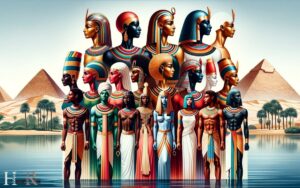
What Color Skin Did Ancient Egypt Have? Light To Dark Brown!
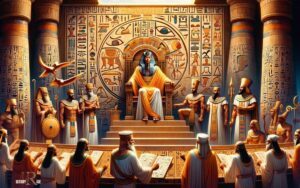
Which God Did Ancient Egypt Fear Most? God Seth!
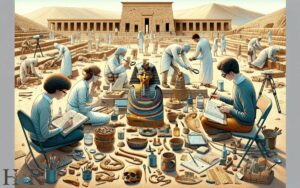
The Study of Ancient Egypt: History, Literature, Art!

Which Form of Government Was Practiced in Ancient Egypt?
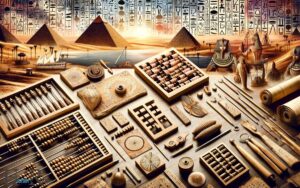
Mathematics in Ancient Egypt a Contextual History: Explain!

How Long to Build a Pyramid in Ancient Egypt? 20 Years!
Leave a reply cancel reply.
Your email address will not be published. Required fields are marked *
Save my name, email, and website in this browser for the next time I comment.
Home — Essay Samples — History — Ancient Egypt — Egypt And Mesopotamia: Compare And Contrast Analysis
Egypt and Mesopotamia: Compare and Contrast Analysis
- Categories: Ancient Civilizations Ancient Egypt
About this sample

Words: 1268 |
Published: Oct 2, 2020
Words: 1268 | Pages: 3 | 7 min read
Table of contents
Egypt and mesopotamia compare and contrast: cultural similarities and drastic differences, women roles and state in ancient societies, works cited.
- Baines, J. (2008). Visual and written culture in ancient Egypt. Oxford University Press.
- Diakonoff, I. M. (1985). The law of the Medes and the Persians: the ancient Near East through Iranian eyes. Eisenbrauns.
- Eichler, B. (2019). Female labor in the Egyptian textile industry. In The Routledge Handbook of Work and Labor Relations in Asia (pp. 165-176). Routledge.
- Gerhardt, B. (2012). Gender roles in ancient Mesopotamia. Columbia University Press.
- Gorman, J. (2010). Women and gender in ancient Egypt : from Prehistory to Late Antiquity. Edinburgh University Press.
- Hallo, W. W. (1997). Legal and administrative texts of the reign of Samsuiluna. Cornell University Press.
- Krebernik, M. (2019). Law and legal practice in Mesopotamia. Oxford Research Encyclopedia of Religion.
- Mackenzie, D. A. (2015). The development of writing in ancient Egypt. Cambridge University Press.
- Robins, G. (1993). Women in ancient Egypt. Harvard University Press.
- Snell, D. C. (2018). Law and order in ancient Mesopotamia. Routledge.

Cite this Essay
Let us write you an essay from scratch
- 450+ experts on 30 subjects ready to help
- Custom essay delivered in as few as 3 hours
Get high-quality help

Verified writer
- Expert in: History

+ 120 experts online
By clicking “Check Writers’ Offers”, you agree to our terms of service and privacy policy . We’ll occasionally send you promo and account related email
No need to pay just yet!
Related Essays
5 pages / 2258 words
2 pages / 746 words
1 pages / 623 words
2 pages / 1095 words
Remember! This is just a sample.
You can get your custom paper by one of our expert writers.
121 writers online
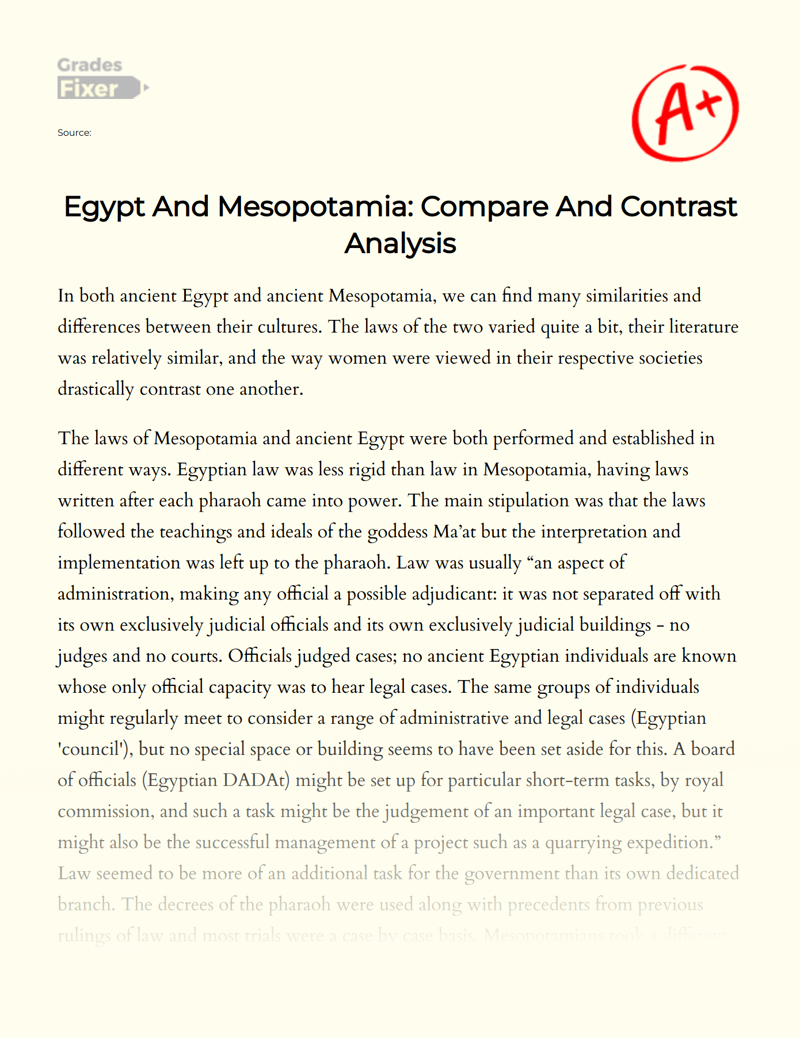
Still can’t find what you need?
Browse our vast selection of original essay samples, each expertly formatted and styled
Related Essays on Ancient Egypt
King Akhenaten, also known as Amenhotep IV, was an ancient Egyptian pharaoh who is best known for his religious reforms and his establishment of a new capital city. His reign was marked by significant changes in religious [...]
In ancient Egypt, the natural landscape played a crucial role in shaping the civilization's development and defining its boundaries. From the mighty Nile River to the vast deserts and towering mountains, natural barriers not [...]
In conclusion, Cleopatra's journey to power was a remarkable one, filled with political intrigue, strategic alliances, and personal sacrifice. Despite the challenges she faced as a woman in a patriarchal society, Cleopatra's [...]
Ramses II, also known as Ramses the Great, was one of the most powerful and influential pharaohs in ancient Egypt. His reign, which lasted for over six decades, was marked by numerous accomplishments that solidified his legacy [...]
The various groups of people that have existed throughout history (both groups that no longer exist, and groups that are still in existence today) have a number of things in common, as well as a multitude of differences. Two [...]
Statuette of the Lady Tiye, standing at 24 centimeters tall, is an Egyptian wood sculpture dating back to the reign of Amenhotep III–Akhenaten, around 1390–1349 B.C. The sculpture shows Tiye, who was the royal wife of Amenhotep [...]
Related Topics
By clicking “Send”, you agree to our Terms of service and Privacy statement . We will occasionally send you account related emails.
Where do you want us to send this sample?
By clicking “Continue”, you agree to our terms of service and privacy policy.
Be careful. This essay is not unique
This essay was donated by a student and is likely to have been used and submitted before
Download this Sample
Free samples may contain mistakes and not unique parts
Sorry, we could not paraphrase this essay. Our professional writers can rewrite it and get you a unique paper.
Please check your inbox.
We can write you a custom essay that will follow your exact instructions and meet the deadlines. Let's fix your grades together!
Get Your Personalized Essay in 3 Hours or Less!
We use cookies to personalyze your web-site experience. By continuing we’ll assume you board with our cookie policy .
- Instructions Followed To The Letter
- Deadlines Met At Every Stage
- Unique And Plagiarism Free

Egypt vs Mesopotamia: Difference and Comparison
Civilization refers to a complex society, which is characterized by established systems of urban development, communication, government, and social stratification.
Modern civilizations of the world have not emerged but evolved over a long period. Egypt and Mesopotamia are two of the major ancient civilizations that are considered a precursor to modern civilizations.
Key Takeaways Egypt was an ancient civilization located along the Nile River in northeastern Africa, while Mesopotamia was situated between the Tigris and Euphrates Rivers in present-day Iraq. Egyptian society was centralized under a pharaoh and heavily influenced by the Nile’s seasonal flooding, while Mesopotamia had multiple city-states with distinct rulers and relied on complex irrigation systems. Egyptian art and architecture featured monumental structures such as pyramids and temples, whereas Mesopotamian culture produced ziggurats and intricate cuneiform writing.
Egypt vs Mesopotamia
Egypt is a country in North Africa that is famous for its ancient civilization and its iconic landmarks such as the pyramids , the Sphinx, and the Nile River. Mesopotamia is a historical region of western Asia that corresponds to present-day Iraq, as well as parts of Iran, Syria, and Turkey.
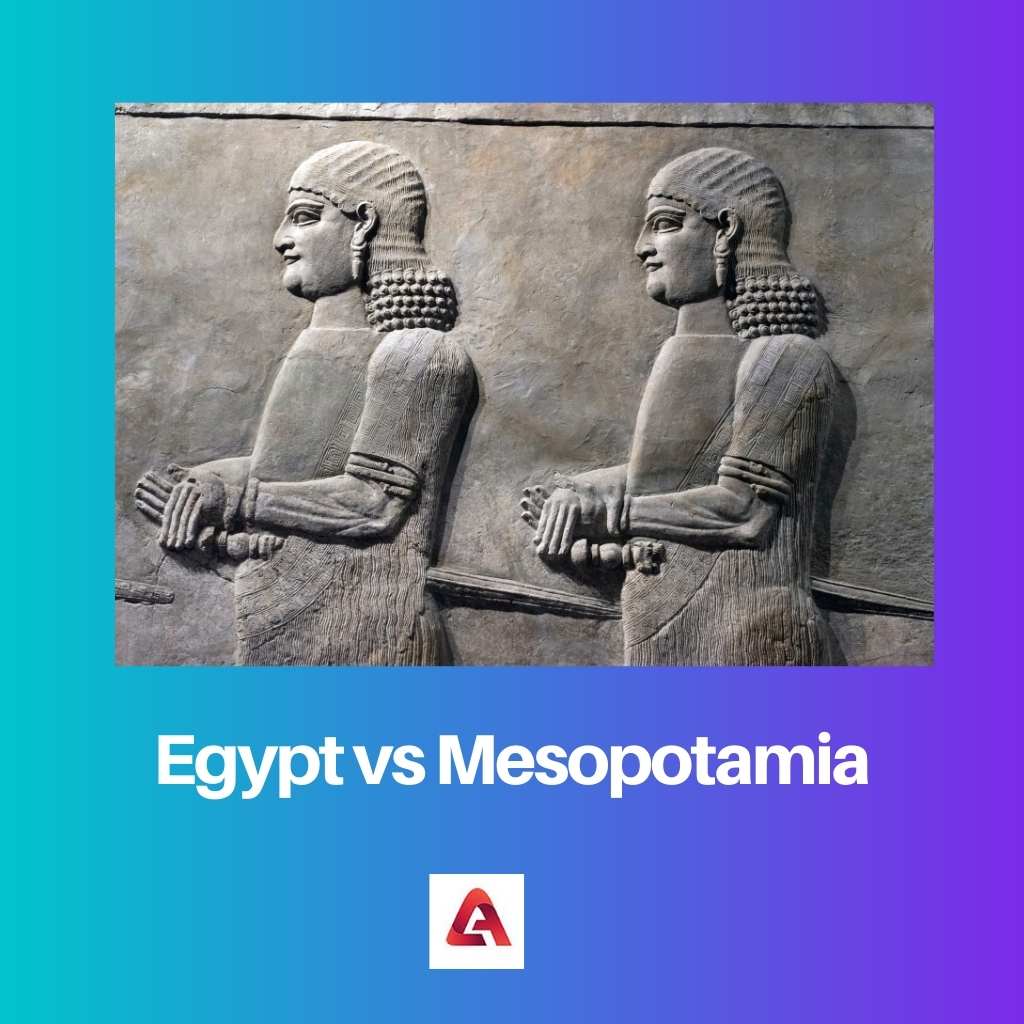
Egypt is a transcontinental country, which occupies the southwest corner of Asia and northeast corner of Africa, and is located on the banks of the Nile River.
It is one of the most ancient civilizations and is considered a ‘cradle of civilization’ due to major strides made by ancient Egypt in the field of agriculture, writing, centralized government, and organized religion.
Mesopotamia is an ancient civilization in Western Asia, which was bordered by Euphrates and Tigris rivers in the Fertile Crescent.
The region was of strategic importance and was conquered by many people, including Alexander the Great. It is also associated with some greatest developments in human history in the fields of agriculture, astronomy, and mathematics.
Comparison Table
What is egypt.
Egypt is situated on the riverbank of the Nile River. It borders two continents, i.e. Asia and Africa and also possesses the isthmus of Suez. It has one of the longest histories in the world.
Due to strides made by ancient Egyptian civilization in areas of surgery, medicine, organized religion, and urbanization, it is dubbed as the ‘cradle for civilization’.
Egypt was an agricultural economy that relied on the Nile River. The political system in Egypt was based on centralization. Egypt was a single political unit, ruled by a Pharaoh, who was assisted by an excellent bureaucracy.
Egyptians believed in the divine theory of state and considered the Pharaoh as the face of God. Pharaohs were succeeded by their eldest son post their death.
The religious practices of Egyptians were dominated by polytheism. Due to the centralized nature of the state, an organized form of religion developed there.
Besides, women were made to participate in society and were given property rights after the death of their husbands.
Egypt is known for its excellent contributions to material culture, in the form of developments in medical technology, cosmetics, papyrus sheets, etc. It is also known for its magnificent pyramids.
Egyptians also developed their script, which was called hieroglyphics and was based on pictures.

What is Mesopotamia?
Mesopotamia is a historical civilization, based in the northern Fertile Crescent that lay between the Euphrates and Tigris river system. This region forms modern-day Iraq in the Middle East.
Mesopotamia has been an important strategic location, which has historically been under the control of Akkadians and Sumerians , followed by the Achaemenid Empire. Later it was conquered by Alexander, too.
The Mesopotamian economy was based on agriculture that heavily relied on the Euphrates and Tigris rivers that bordered it. The political system in Mesopotamia was based on decentralization.
Mesopotamia was a collection of loosely connected self-governing states that functioned democratically. However, it later converted into a monarchy.
Mesopotamians practiced polytheism, but due to the decentralized nature of their polity and society, different variants emerged in the constituent subunits. Besides, the condition of women was not as appreciable.
They were not given any property rights. It is the site of developments in the Neolithic Revolution, as well as breakthroughs in agriculture, mathematics, and astronomy.
It is also famous for its architectural marvels like ziggurats and architectural styles of arches, columns, and roofed buildings. Mesopotamians also developed a script called cuneiform.
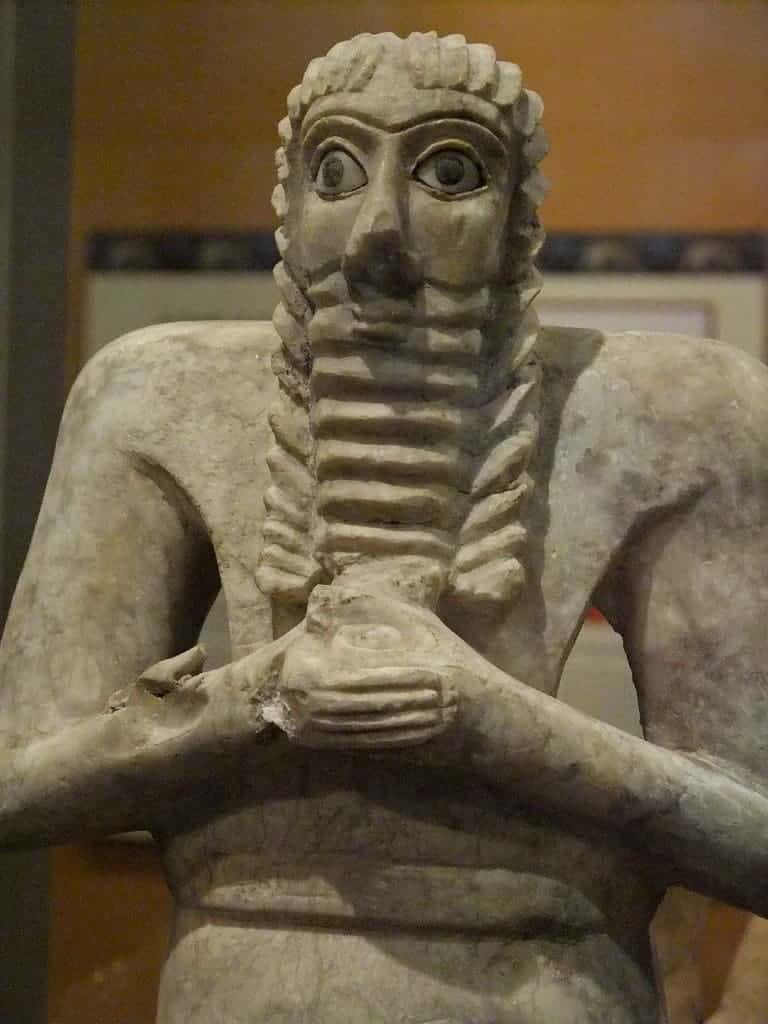
Main Differences Between Egypt and Mesopotamia
- Egypt and Mesopotamia differ in their geographical location. Egypt is a subtropical country that borders Asia and Africa and is located on the Nile riverside. Mesopotamia was located in the Fertile Crescent between Euphrates and Tigris rivers.
- The political system in Egypt was a centralized one, under a Pharaoh. Politics in Mesopotamia was based on decentralization, comprising several units.
- Egyptian architecture is famous for its pyramids, while Mesopotamian architecture is famous for its ziggurat.
- Egyptians used a script with a system of pictures called hieroglyphics, whereas Mesopotamians developed cuneiform script.
- The condition of women was better in Egypt than in Mesopotamia, as women were granted property rights after the death of their husbands in the former, but not in the latter.
- Both Egyptians and Mesopotamians practiced polytheism, i.e. worshipping multiple deities; but religion was organized in Egypt, while regional variants developed in Mesopotamia.
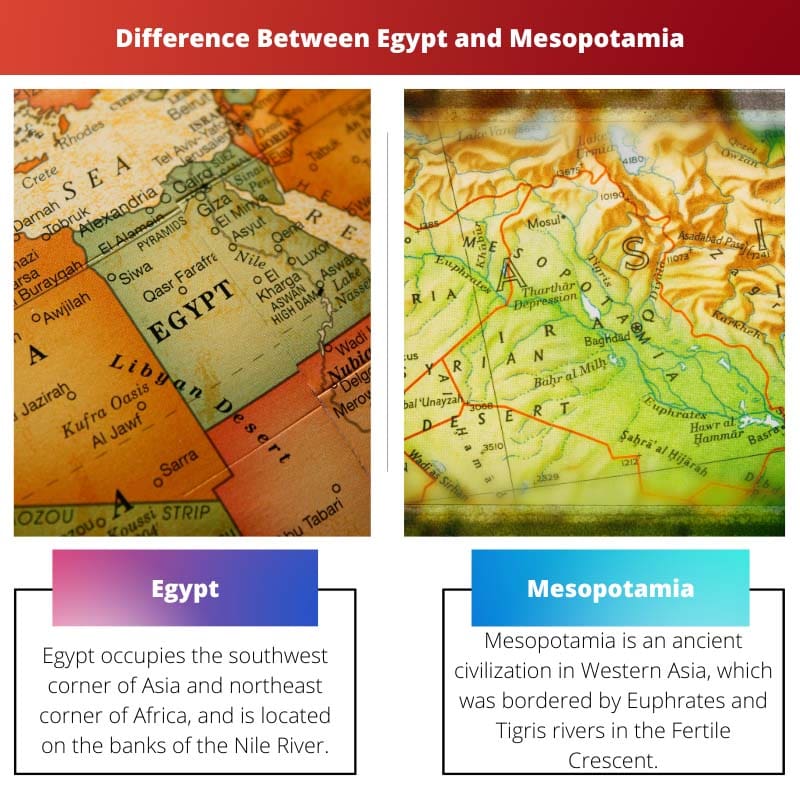
- https://search.proquest.com/openview/1cec85ee1bd8e1526826e7a36a43a28a/1?pq-origsite=gscholar&cbl=40991
- https://www.journals.uchicago.edu/doi/pdf/10.1086/371676
Last Updated : 13 July, 2023

I’ve put so much effort writing this blog post to provide value to you. It’ll be very helpful for me, if you consider sharing it on social media or with your friends/family. SHARING IS ♥️
Piyush Yadav has spent the past 25 years working as a physicist in the local community. He is a physicist passionate about making science more accessible to our readers. He holds a BSc in Natural Sciences and Post Graduate Diploma in Environmental Science. You can read more about him on his bio page .
Similar Reads
- Egypt vs China: Difference and Comparison
- Egypt vs Nubia: Difference and Comparison
Share this post!
Leave a comment cancel reply.
Save my name, email, and website in this browser for the next time I comment.
Want to save this article for later? Click the heart in the bottom right corner to save to your own articles box!
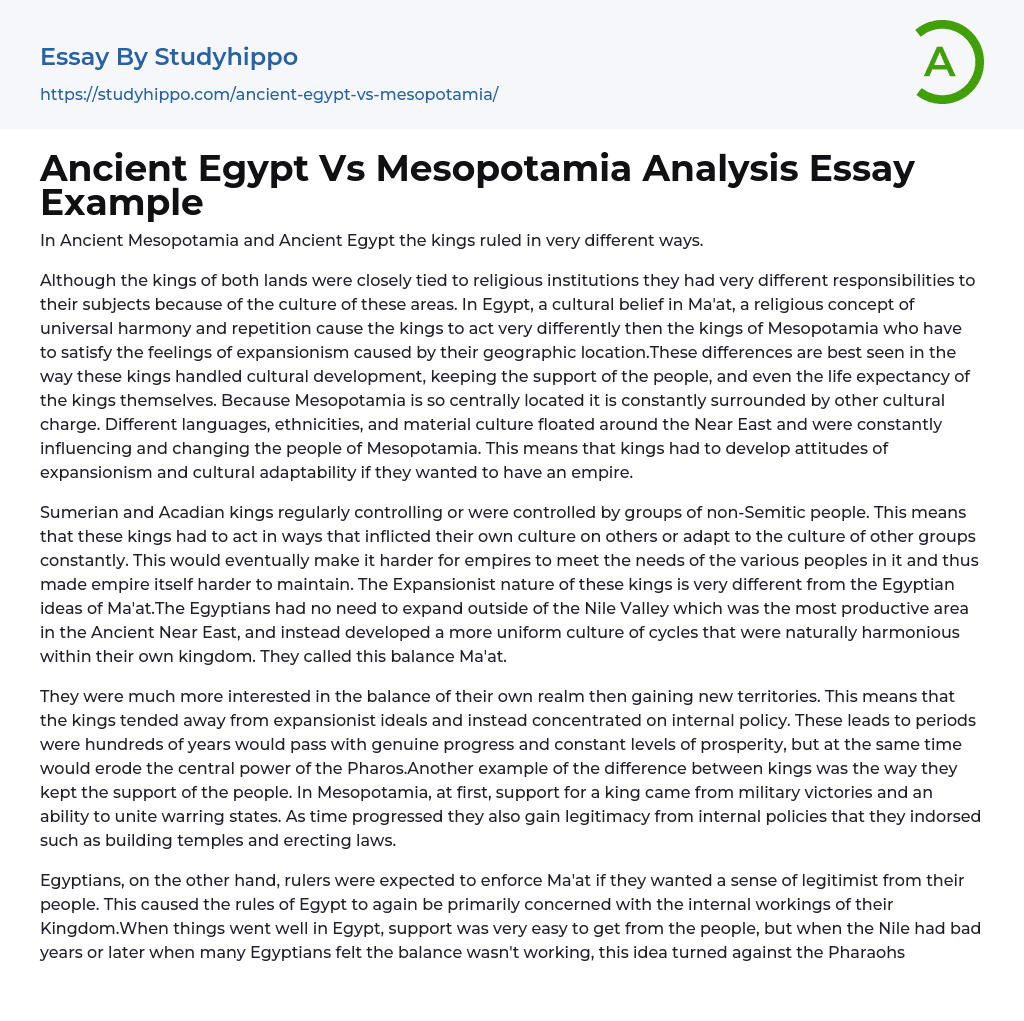
Ancient Egypt Vs Mesopotamia Analysis Essay Example
- Pages: 3 (762 words)
- Published: November 1, 2017
- Type: Essay
In Ancient Mesopotamia and Ancient Egypt the kings ruled in very different ways.
Although the kings of both lands were closely tied to religious institutions they had very different responsibilities to their subjects because of the culture of these areas. In Egypt, a cultural belief in Ma'at, a religious concept of universal harmony and repetition cause the kings to act very differently then the kings of Mesopotamia who have to satisfy the feelings of expansionism caused by their geographic location.These differences are best seen in the way these kings handled cultural development, keeping the support of the people, and even the life expectancy of the kings themselves. Because Mesopotamia is so centrally located it is constantly surrounded by other cultural charge. Different languages, ethnicities, and material culture floated around the Near Ea
st and were constantly influencing and changing the people of Mesopotamia. This means that kings had to develop attitudes of expansionism and cultural adaptability if they wanted to have an empire.
Sumerian and Acadian kings regularly controlling or were controlled by groups of non-Semitic people. This means that these kings had to act in ways that inflicted their own culture on others or adapt to the culture of other groups constantly. This would eventually make it harder for empires to meet the needs of the various peoples in it and thus made empire itself harder to maintain. The Expansionist nature of these kings is very different from the Egyptian ideas of Ma'at.The Egyptians had no need to expand outside of the Nile Valley which was the most productive area in the Ancient Near East, and instead developed a more uniform culture of cycles that wer
naturally harmonious within their own kingdom. They called this balance Ma'at.
They were much more interested in the balance of their own realm then gaining new territories. This means that the kings tended away from expansionist ideals and instead concentrated on internal policy. These leads to periods were hundreds of years would pass with genuine progress and constant levels of prosperity, but at the same time would erode the central power of the Pharos.Another example of the difference between kings was the way they kept the support of the people. In Mesopotamia, at first, support for a king came from military victories and an ability to unite warring states. As time progressed they also gain legitimacy from internal policies that they indorsed such as building temples and erecting laws.
Egyptians, on the other hand, rulers were expected to enforce Ma'at if they wanted a sense of legitimist from their people. This caused the rules of Egypt to again be primarily concerned with the internal workings of their Kingdom.When things went well in Egypt, support was very easy to get from the people, but when the Nile had bad years or later when many Egyptians felt the balance wasn't working, this idea turned against the Pharaohs and many kings lost support because of forces beyond their control. Even the life expectancy of the kings, and thus the effectiveness of their rule, was controlled by these different ideas of expansionism and Ma'at.
Under the Egyptian ideas kings seemed to live and enjoy long reigns during at first when the Ma'at was good.In the later Dynasties when people began to shift the power of Ma'at for this world's
leaders to the next world's judges the kings tended to have shorter reigns and could no longer rely on natural harmony to keep them in power. Mesopotamian kings also did not fare as well in times of depression of drought, but it was just as likely that they would die in a battle against the Elamites or any other invading force. We see a much higher rate of kings dying in battles in the Near East than in Egypt.
This means that kings were on the frontline or at least in the wars with their armies.This is strikingly different than our image of the God like Egyptian ruler removed from the scene of battles. Even though both kings, Egyptian and Mesopotamian, had to gain legitimacy from their people and control their empire, the actions they had to perform to do these things is strikingly different. Even as culture and people of Egypt and Mesopotamia changed their views on Ma'at and expansion the rulers had to adjust, they adjusted in different ways.
The actions of Kings will always be bound by their culture whether it is a culture of expansion or a culture or consistency.
- Death in Ancient Egypt Essay Example
- Pharaohs of Egypt Essay Example
- Hatshepsut Essay Example
- Who Built the Pyramids Essay Example
- Ancient Egypt and Ancient China similarities and differences Essay Example
- Rosetta Stone Essay Example
- Dress Style in the Ancient Egypt Essay Example
- The Narmer palette Essay Example
- Tourism in Egypt: reasons behind its deterioration Essay Example
- Egyptian Pharaoh Tutankhamuns Tomb Essay Example
- Sumerian Ziggurats Essay Example
- Ancient Egyptian Calendar Essay Example
- The Great Sphinx Essay Example
- Ancient Egypt vs Modern Egypt Essay Example
- The Statue of the Egyptian Scribe Haremhab Essay Example
- Abolitionism essays
- Adam Smith essays
- American History essays
- American Revolution essays
- Ancient Egypt essays
- Articles Of Confederation essays
- Atlantic Slave Trade essays
- Aztec essays
- Benjamin Franklin essays
- Civil Rights Act of 1964 essays
- Civil Rights Movement essays
- Civil war essays
- Cleopatra essays
- French And Indian War essays
- Gettysburg essays
- Great Depression essays
- Hurricane Katrina essays
- Industrial Revolution essays
- Jamestown essays
- Manifest Destiny essays
- Mccarthyism essays
- Patrick Henry essays
- Pearl Harbor essays
- Pocahontas essays
- Prohibition essays
- Pyramids essays
- Salem Witch Trials essays
- Slavery essays
- The New Deal essays
- Thirteen Colonies essays
- Westward Expansion essays
- Egypt essays
- Iran essays
- Iraq essays
- Israel essays
- Saudi Arabia essays
- Syria essays
- John Locke essays
- 9/11 essays
- A Good Teacher essays
- A Healthy Diet essays
- A Modest Proposal essays
- A&P essays
- Academic Achievement essays
- Achievement essays
- Achieving goals essays
- Admission essays
- Advantages And Disadvantages Of Internet essays
- Alcoholic drinks essays
- Ammonia essays
Haven't found what you were looking for?
Search for samples, answers to your questions and flashcards.
- Enter your topic/question
- Receive an explanation
- Ask one question at a time
- Enter a specific assignment topic
- Aim at least 500 characters
- a topic sentence that states the main or controlling idea
- supporting sentences to explain and develop the point you’re making
- evidence from your reading or an example from the subject area that supports your point
- analysis of the implication/significance/impact of the evidence finished off with a critical conclusion you have drawn from the evidence.
Unfortunately copying the content is not possible
Tell us your email address and we’ll send this sample there..
By continuing, you agree to our Terms and Conditions .

- Dissertation Chapter - Abstract
- Dissertation Chapter - Introduction Chapter
- Dissertation Chapter - Literature Review
- Dissertation Chapter - Methodology
- Dissertation Chapter - Results
- Dissertation Chapter - Discussion
- Dissertation Chapter - Hypothesis
- Dissertation Chapter - Conclusion Chapter
Get access to the final draft
You will be notified once the essay is done. You will be sent a mail on your registered mail id about the details of the final draft and how to get it.
Finished Papers
260 King Street, San Francisco
Updated Courtyard facing Unit at the Beacon! This newly remodeled…

IMAGES
VIDEO
COMMENTS
4674. Egypt and Mesopotamia developed within close proximity and time frames to one another, but in drastically different ways. Part of these differences was due to geography, part was due to law codes, and part was due to social structure and government. Both civilizations followed a similar pattern in their origins, but diverged as they ...
Both the civilizations of Mesopotamia and Egypt developed around rivers: Tigris-Euphrates and Nile respectively. The political structure of Mesopotamia was a network of city-states while Egypt was a unified state. The Mesopotamians developed a form of writing called cuneiform while the Egyptians developed hieroglyphics.
by Kelly Macquire. published on 16 May 2021. In this video, we are comparing Ancient Egypt vs. Mesopotamia in all sorts of different aspects. We will be looking at the similarities and differences between the geography of the two regions, the phenomena of the flooding Nile vs. the flooding Tigris and Euphrates rivers, and how the geography and ...
The development of Mesopotamia and Egyptian are river valley civilizations similar in their development along rivers. Mesopotamia was founded along the Tigris and Euphrates rivers in the Middle East while Egypt was founded along the Nile River in North-East Africa. Many historians agree that people in these civilizations settled in the river ...
Women in Mesopotamia and Ancient Egypt were treated very differently than each other, with Egypt being a more egalitarian society and Mesopotamia treating women more like property of their husbands or fathers. In Egypt, women and men were held in the same regard legally. Most rights that applied to men also extended to the women.
Mesopotamia and Egypt were two of the earliest complex societies to emerge in human history. With social hierarchy, division of labor, writing, religion, and technological advancement, these two ...
In this video, we are comparing Ancient Egypt vs. Mesopotamia in all sorts of different aspects. We will be looking at the similarities and differences betwe...
Civilization involves high level developments on the cultural, political and social aspects of a region or a country. Mesopotamia and Egypt can be described as the two earliest civilizations which were located along the great river systems. Mesopotamia and Egypt had well established religion, art, architecture, education as well as political ...
Essay on Compare and Contrast Egypt and Mesopotamia. Egypt developed around the Nile River, while Mesopotamia developed between the Tigris and Euphrates rivers. Egypt and Mesopotamia grew into complex civilizations. Politically, both Egypt and Mesopotamia had a government with one main ruler, but Egypt had a centralized government with a ...
Views. 569. The ancient civilizations of Mesopotamia and Egypt offer fascinating insights into the diverse aspects of human society and culture during antiquity. While these two civilizations share certain similarities, such as their polytheistic religious beliefs, they also exhibit significant differences in areas like governance and the ...
Mesopotamia and Egypt were both in flood basins of major rivers. Mesopotamia was characterized by turmoil and tension and in contrast Egypt was characterized by stability and serenity. The Mesopotamian climate was harsh and since the Tigris and the Euphrates flooded irregularly, …show more content…. In the beginning Egypt was divided into ...
Ancient Egypt and Mesopotamia were an agricultural based society that believed in the existence of many deities; however, they differed in the aspect of how they evolved as an agricultural society and whether they feared or praised their gods. Mesopotamia, also known as the Fertile Crescent, was located inside the Euphrates and Tigris River.
Egypt vs Mesopotamia. Egypt is a country in North Africa that is famous for its ancient civilization and its iconic landmarks such as the pyramids, the Sphinx, and the Nile River.Mesopotamia is a historical region of western Asia that corresponds to present-day Iraq, as well as parts of Iran, Syria, and Turkey.
This Mesopotamia and Egypt essay, therefore, will compare and contrast the two civilizations. One of the significant Mesopotamia and Egypt similarities is their social structure. Both Egyptians and Mesopotamians had a well-structured social class system. The slaves and peasants both played similar roles in both Egyptian and Mesopotamian society ...
Egypt Vs Mesopotamia Essay. 340 Words2 Pages. Mesopotamia and Egypt were two of the first civilizations to emerge along the banks of large rivers. Ancient Egypt civilization was said to be around 3000 BC-2000 BC, while Mesopotamia 's civilization was around 3500 BC-1600 BC. During this time was the Aegean Bronze Age, where trade network, desire ...
Deniz Nemli Egypt and Mesopotamia Comparative Essay Egyptian and Mesopotamian religious beliefs were both polytheistic and both had gods that judged the citizens for their actions, however Mesopotamians believed death to be an extremely bleak matter while the Egyptians had relatively positive belief of a life that continued after death, and the ...
egypt vs mesopotamia Essay. Andres Contreras Civilizations I Professor Pace March 04, 2013 The ancient civilization of Mesopotamia was located west of the Iranian Plateau or what it's known today as modern Iraq. Beside it, a second civilization began to establish in northeast Africa, along the Nile River. The Egyptians, a civilization with ...
Ancient Egypt and Mesopotamia were an agricultural based society that believed in the existence of many deities; however, they differed in the aspect of how they evolved as an agricultural society and whether they feared or praised their gods. Mesopotamia, also known as the Fertile Crescent, was located inside the Euphrates and Tigris River.
Egypt Vs Mesopotamia Essay. 555 Words 3 Pages. Egypt and Mesopotamia were both two of the earliest known civilizations. Egypt was built on both sides of the Nile River, while Mesopotamia was built in between Tigris River, and Euphrates River. Their positions permitted water resources that granted fertile land for agriculture.
Ancient Egypt Vs Mesopotamia Analysis Essay Example. In Ancient Mesopotamia and Ancient Egypt the kings ruled in very different ways. Although the kings of both lands were closely tied to religious institutions they had very different responsibilities to their subjects because of the culture of these areas. In Egypt, a cultural belief in Ma'at ...
Egypt Vs Mesopotamia Essay. Improved Essays. 683 Words; 3 Pages; Open Document. Essay Sample Check Writing Quality. Show More. The argument of the civilizations of Mesopotamia and Egypt. Both have many important similarities and differences. However, the difference between the two civilization serve as a clear evidence to the existence of ...
Egypt Vs Mesopotamia Essay, Custom Creative Writing Writers Service Usa, Creative Writing Worksheets For Grade 2, Wells Fargo Resume For Teller, Econometrics Master Thesis, How Does A Memior Differ From A Personal Essay, Top School Application Letter Ideas. Min Beds. Any. 4.8 stars - 1630 reviews. Egypt Vs Mesopotamia Essay -.
Essay writing help has this amazing ability to save a student's evening. For example, instead of sitting at home or in a college library the whole evening through, you can buy an essay instead, which takes less than one minute, and save an evening or more. ... Egypt Vs Mesopotamia Essay, Five Paragraph Essay Topics High School, Business Plan ...